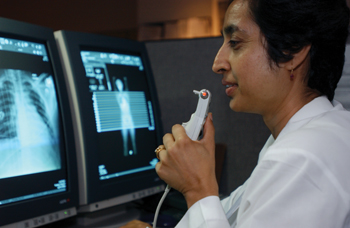
Sudha Singh, M.D., uses the new voice recognition system being tested at the Monroe Carell Jr. Children's Hospital at Vanderbilt.
Photo by Susan Urmy
Voice recognition system may speed note transcription
Sudha Singh, M.D., a pediatric radiologist, reviews a black and white CT-scan image on a large computer screen while speaking into a hand-held device.
The device is a microphone attached to a second, smaller, green-colored screen. As she speaks, words appear. When she finishes her assessment she carefully reviews the words that have formed themselves into a full report on the green screen and smiles.
“Look at that — 100 percent,” she says, then commands the screen to “Sign off report.”
Singh is using “Talk Tech,” a speech recognition system for taking medical dictation. This version, called “TalkStation,” by AGFA, is designed especially for Radiology but can be tailored to most any specialty.
The Pediatric Diagnostic Imaging Department at the Monroe Carell Jr. Children's Hospital at Vanderbilt is the first on the Medical Center campus to test the technology.
“Probably the best part about this system is the time savings,” Singh said. “You can turn around a big study right away, and it's available on our Star Chart system within five minutes.”
Traditionally, radiologists, like most other physicians, use telephone dictation services to report findings on patient examinations. The radiologist dials up the service and dictates into a Dictaphone system. A transcriptionist on the other end of the line types what the physician says. Then the document is sent back to the physician through a specialized computer link. After reviewing and correcting the document the physician signs off on the report.
“But if it's a weekend, and there are fewer people working at the dictation service, you could call in a report during the morning and it might not get completed until, say, 1 a.m., and I won't get a chance to review it and sign off on it until the next day,” Singh said.
“That can mean a delay in getting information back to the referring physician, and, in turn, the patient who is waiting to hear the results.”
With Talk Tech, the phone calls are eliminated. The computer “learns” the physician's voice and when a word is spoken it appears on the screen. Singh is able to speak at a fairly normal pace and can sign off on a report more quickly.
“The one-time cost of installing the system is significant,” said Kim Halliburton, the administrative director of Diagnostic Imaging at Children's Hospital. “It's about $240,000, plus $22,000 a year in maintenance costs, but even with that in mind we believe it would save money. In fact, the system should pay for itself in almost a year because we currently spend about $200,000 a year on transcription.”
The time-saving benefit is appealing to most people, but as with any new technology, there are questions about whether the department should come to rely so heavily on a computer system.
“There are drawbacks,” Singh said. “I had a cold once and it would not recognize my voice. There will always be a need for a backup system. Then again, I would not have been able to use the old system either, for I lost my voice. However, with the Talk Tech I was able to do my share of work by typing in the reports.”
The Pediatric Diagnostic Imaging Department at Children's Hospital will work with the system for a few more weeks before making a decision on purchasing.
“We've already begun to experience benefits, such as reduced turn around times on reports and increased satisfaction of our referring physicians and patients,” Halliburton said.













